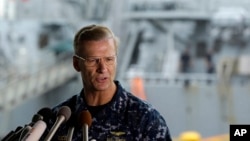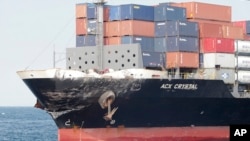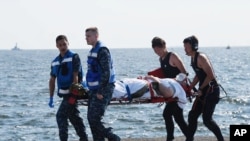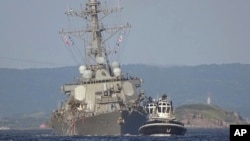Investigators are looking into the crash of a U.S. Navy destroyer and cargo ship off the coast of Japan that killed seven sailors.
The USS Fitzgerald and a Philippine-registered container ship crashed early Saturday south of Tokyo Bay.
The United States and Japan have since launched investigations into what might have caused the crash.
U.S. Navy experts say collisions involving such ships are not common.
Vice Admiral Joseph Aucoin is commander of the U.S. Seventh Fleet, based at Yokosuka naval base in Japan. Speaking to reporters Sunday, he said the crash happened at around 2:20 a.m., as many crew members slept. He added that it is Navy policy to have some crew members keeping watch throughout the night. No bad weather was reported.
Aucoin said he did not know if crew members heard a warning before the crash. He also said he was not sure what conditions the seven sailors who died faced.
“So unfortunately, we don't have the details regarding the conditions during the final moments, but hope that the investigation may shed some light on that matter.”
Three other U.S. crew members were injured in the accident, including the commander of the Navy ship, Bryce Benson. Benson was in stable condition with a head injury. The other sailors suffered minor injuries.
Aucoin praised crew members for fighting to keep the damaged ship above water and working to reduce flooding. He said the USS Fitzgerald can be repaired, but it will take many months.
The much larger container ship, the ACX Crystal, suffered less damage than the USS Fitzgerald. None of its crew members were injured.
Ralph Cossa is president of the Pacific Forum at the Center for Strategic and International Studies in Hawaii. He said the crash left many unanswered questions.
“I’m sure there’s going to be a significant investigation to try to figure out how something like this could happen. It was in the middle of the night, but still there’s somebody on watch and in command of the ship at all times. So I just don’t understand how a vessel of that size could have managed to end up colliding.”
Cossa said he believes the Navy ship was in the area after recently holding exercises with Japanese forces.
“Normally you wouldn’t expect a destroyer to be out there all by itself. There would be other ships that it would be accompanying or involved with.”
He added that the location -- about 100 kilometers southwest of Yokosuka, Japan -- has a lot of shipping traffic all the time.
“This is a very busy waterway, which is why people are always supposed to be quite vigilant in watching out when they are operating.”
He said that the ACX Crystal likely does not have the monitoring ability of the Navy destroyer.
The USS Fitzgerald is one of the most advanced warships in the U.S. Navy. Such ships are equipped with modern monitoring tools that track other nearby ships. These tools can warn crew members of the danger of collisions.
Vice Admiral Aucoin said he could not provide information on what systems were operating aboard the destroyer at the time of the crash.
Along with the warship’s technical systems, the investigation is also expected to center on what crew members of both vessels were doing at the time of the crash.
Another focus will be on whether the container ship was following international rules covering shipping traffic. The rules are included in the United Nations’ Convention on the International Regulations for Preventing Collisions at Sea.
The convention provides guidelines on how to deal with many possible dangers. Among these are steps for how vessels should yield to each other when passing in order to prevent collisions.
I’m Bryan Lynn.
Bryan Lynn wrote this story for VOA Learning English, based on reports from VOA News, the Associated Press and Reuters. Ashley Thompson was the editor.
We want to hear from you. Write to us in the Comments section, and visit our Facebook page.
________________________________________________________________
Words in This Story
collision – n. crash when two or more things hit each other
unfortunately – adj. used by a person to say something bad or unlucky happened
accompany – v. go somewhere with
vigilant – adj. watching carefully for signs of problems or danger
guideline – n. rule or instruction for how something should be done
significant – adj. important or noticeable
shed light on – expression. to help to explain something by providing additional information
monitor – v. watch or observe over a period of time
yield – v. allow another car, ship, etc. to go ahead before you












